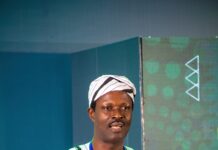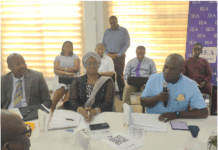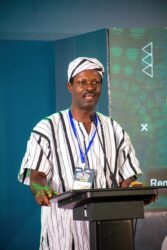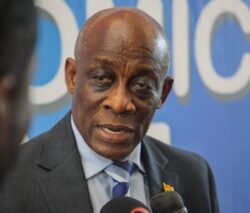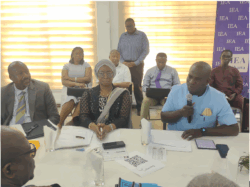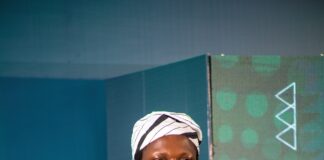Nana Anoff, a self-taught artist, is set to hold a new exhibition dubbed: ‘8mm’, which investigates the impact of exposure on a person’s life; and it will take place at The Mix Design Hub in Osu from September 17 to October 7, 2022.
The title of his upcoming show comes from an 8mm film projector used in one of the works (‘Mother and Child’), as well as the artist asking himself: “How could an 8mm projector change a woman’s life?”
The titles of the works often present themselves as truisms inspired by artist Nana Anoff’s observations, dreams and aspirations. Often explored from the point of view of the personal and the local, the works, nonetheless, touch on contemporary and universal themes of politics, environmentalism and materiality.
Nana Anoff, a self-taught artist, who has explored charcoal, pencil, watercolour, acrylic and oil painting not only works with metals from automobiles, but also integrates other materials to create stories that highlight the hardworking African – a theme that runs through most of his works. Since 2000 when he had his first exhibition, Anoff has been exhibited both locally in Ghana and internationally.
His commissioned works are showcased in prominent spaces such as Al-Rayan International School and Mercedes Benz Dealership (Silver Star), The Kofi Annan International Peace Keeping Centre, Centre for Democracy and Development, Standard Chartered Bank head office, and the Supreme Court of Ghana.
Anoff’s works are composed of assembled and scavenged materials, as well as found objects. These materials include airplane, bicycle, car and motorcycle parts, and often scrap wood from construction sites, sawmills and markets. Anoff transforms these materials into sculptural forms by cleaning, cutting, varnishing and welding. For the artist, it is important to “make use of what is readily available”, as well as maintain the integrity of the materials by not radically changing them.
Generally, these materials highlight the consumerist nature of contemporary society. From electronic waste to rapid urbanisation, consumption is constantly trying to catch up with production. Or is it that production is in a race to catch up with consumption? By preserving the histories of these materials, the artist helps us reflect on this paradox. For example, electronic waste imported into Ghana might refer to unequal power relations between the so-called first world and the so-called third world. We are led to think around the systems and structures that enable global capitalism. But whose capitalism is it anyway? In contrast, construction site scrap shows practices of in-country capitalism.
Anoff is a self-taught artist whose art practice started with watercolour painting. Due to a lack of framing services, he soon found himself making his own frames for the work. But as he self-reports, he was told that his frames were competing with the paintings. He then asked himself what else they could be. What emerged is his current approach of assemblage and sculptures.
Anoff sees a strong link between his paintings and sculptures. The sculptures carry over many underlying themes in his paintings, as well as figurative aspects of his work – long necks, skinny hands and body. The neck is important to the artist, his reason being that the neck directly carries the head.
In the past few years, Anoff has been preoccupied with transportation figures, particularly motorcycles and horses. These figures populate the show. For example, ‘The Hurdle’ is a horse figure which seems to be jumping over an obstacle. Anoff does not remember exactly how he came by the motor figures in his work; he speculates that it might be because his brother had a motorcycle accident.
Imitating the traditional drums with a male and female counterpart, ‘Talking Drums’ is a couplet. It is one of the works that emphasises the artist’s longing for the past while delivering a bit of much needed wisdom, in that the traditional role of the drum is to instigate a response from the community that it serves.
‘Power to the People’ is one of the works that has a political theme. Anoff started working on this piece during the last energy crisis in 2016, and he kept revisiting it. The title of the work could be read as ambiguous. On the one hand, it could be a literal allusion to the energy crisis from which the work sprang; and on the other, it could be a reference to the rallying call for community organisation as used by the American Black Panther Party: “All power to the people!”


